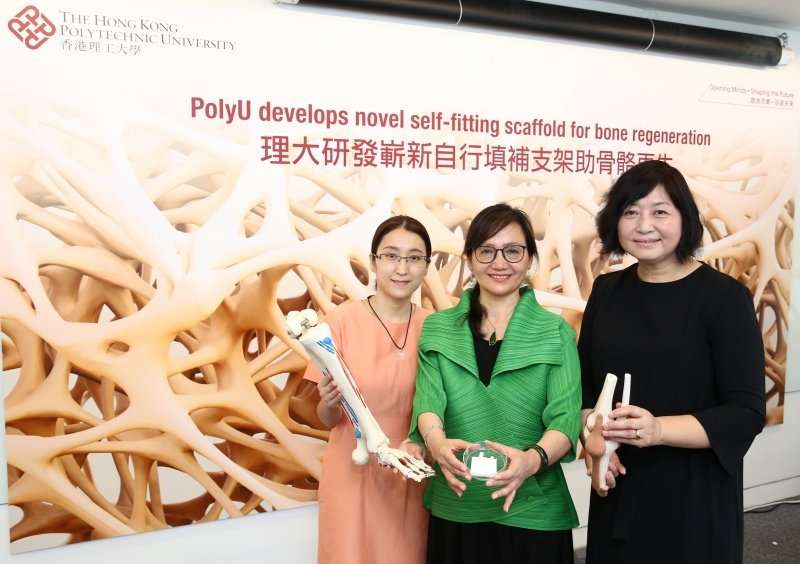Team develops novel self-fitting scaffold for bone regeneration

Researchers from the Hong Kong Polytechnic University (PolyU) have designed and fabricated a high-performing, self-fitting bone scaffold by combining a shape memory foam and hydroxyapatite, the principal mineral component of bone tissue. It can be safely and conveniently implanted into bone defects and induce bone regeneration, thus enhancing the recovery of bone injuries and fractures.
Despite the regenerative capacity of bone, for large bone defects due to bone tumor resections or severe fractures, bone grafting surgeries (autografts or allografts) are always required for orchestrating bone regeneration. With bone fracture becoming a rising worldwide health concern, especially for aging societies, improving grafting processes or effectively inducing bone regeneration have become rising challenges for scientists. For example, a recent study projected that the number of annual new cases of hip fractures from osteoporosis in Hong Kong will triple by 2050; Malaysia and Singapore will increase 3.5 times during the period.
One promising field explored by tissue engineering scientists is to develop a bone scaffold that can act as a template for speedy tissue regeneration, and can be used in minimally invasive operations so as to reduce hospitalization stay and infection risk. The novel scaffold developed by the team of PolyU researchers, led by Professor Hu Jinlian (Principal Investigator) and Dr. Xie Ruiqi from the Institute of Textiles and Clothing, and Dr. Guo Xia from the Department of Rehabilitation Sciences, is a promising breakthrough. The team collaborated with researchers from Sichuan University.
The novel scaffold is made of shape memory polyurethane foam and hydroxyapatite (HA) nanoparticles. It is characterized by its remarkable self-fitting effect. As a shape memory material, the scaffold can be compacted at 0° C, implanted with compact shape at room temperature, and expand to its original shape at 40° C. The scaffold thus fills in the irregular bone defects perfectly. The transitional temperatures, with a range close to human body's physiological temperatures, also enhance the feasibility of using the scaffold in minimally invasive surgery.
The self-fitting scaffold possesses a highly porous structure with interconnected pores to allow cell migration and formation of new tissues. The average pore size of the scaffold is 670 μm, which is close to that of the inner layer of bone, and thus mimics the actual in vivo microenvironment. The optimal structure of the scaffold is around 60 percent of space voids.
If the mechanical strength of the scaffold is too low, deformation or crash may occur; if it is too high, the density of surrounding bone tissue may be reduced. The compressive strength of the PolyU developed self-fitting scaffold is designed at 13.6MPa, which is comparable to that of the inner trabecular bone tissue. Laboratory tests also show that the self-fitting scaffold is biocompatible and has no cytotoxicity.
Animal study on bone regeneration
"Our research team further examined the performance of the self-fitting scaffold in facilitating bone regeneration through a rabbit femoral defect study. The results show that our scaffold has overcome the disadvantages of traditional polymer scaffolds, and has great potential for bone regeneration," said Professor Hu.
In the animal study, 18 rabbits with a femoral bone defects in each knee, making up a total of 36 lesions, were divided into an experimental group and a control group.
The bone defects of the rabbits in the experimental group were implanted with self-fitting scaffolds with original size around 5 percent larger than the bone defects, compacted to around 50 percent of their original size. After triggering with 40° C saline, the scaffolds expanded from the compacted shape to fill the defect in 60 seconds. The bone defects in the control group were left unfilled.
Twelve weeks after the surgery, the experimental group displayed faster bone tissue ingrowth as measured by volume. There was 46 percent bone ingrowth, or the proportion of total defects being repaired. By contrast, the control group had only 24 percent.
The self-fitting scaffold reliably induces the formation of osteoblasts and blood vessels, which are responsible for the synthesis of bone tissue. In the experimental group, 12 weeks after the surgery, the number of neovascular buds grown on the scaffolds was four times of that of the control group. Moreover, 5 percent of the bone surface was covered by osteoblasts in the experimental group, whereas the control group recorded almost no osteoblasts.
In conclusion, the novel shape memory scaffold developed by PolyU has the advantages of:
- minimally invasive implantation
- self-adaption and self-fitting
- optimal structure for bone remodeling
- full biocompatibility
- optimal mechanical properties.
More information: Ching-Lung Cheung et al. An updated hip fracture projection in Asia: The Asian Federation of Osteoporosis Societies study, Osteoporosis and Sarcopenia (2018). DOI: 10.1016/j.afos.2018.03.003



















